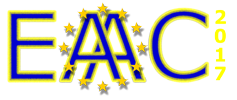Speaker
Mr
Alexander Knetsch
(Deutsches Elektronen-Synchrotron, DESY)
Description
Trojan Horse (TH) Injection in a beam-driven plasma wakefield accelerator(PWFA)[1], which is predicted to generate sub 0.1 µm-emittance electron bunches. The scheme decouples the excitation of the accelerating field by the driving electron bunch from the injection of the witness bunch, triggered by a tightly focused co-propagating laser pulse. This allows for a precise release of electrons at the right phase of the wake by alignment and timing of the laser. To trap the electrons, which are released at rest by the laser, strong accelerating fields are required. So far, such fields have only been established in a plasma wakefield accelerator. It has been shown that phase velocity retardation in TH-PWFA does not need to increase the emittance so that trapping can be facilitated [2].
Recently GeV/m accelerating fields have been demonstrated in dielectric wake fields [3]. With such strong fields, Trojan Horse Injection into wakefields in a dielectric structure is possible.
Implications of TH injection into dielectric wakefield accelerators and simulation results are presented.
[1]B. Hidding et al., PRL, 2012
[2]A. Knetsch et al., submitted 2017
[3]B. O’Shea, Ph.D. thesis UCLA, 2014
Primary author
Mr
Alexander Knetsch
(Deutsches Elektronen-Synchrotron, DESY)
Co-authors
Prof.
Bernhard Hidding
(University of Strathclyde / Hamburg)
Dr
Jens Osterhoff
(Deutsches Elektronen-Synchrotron DESY)

